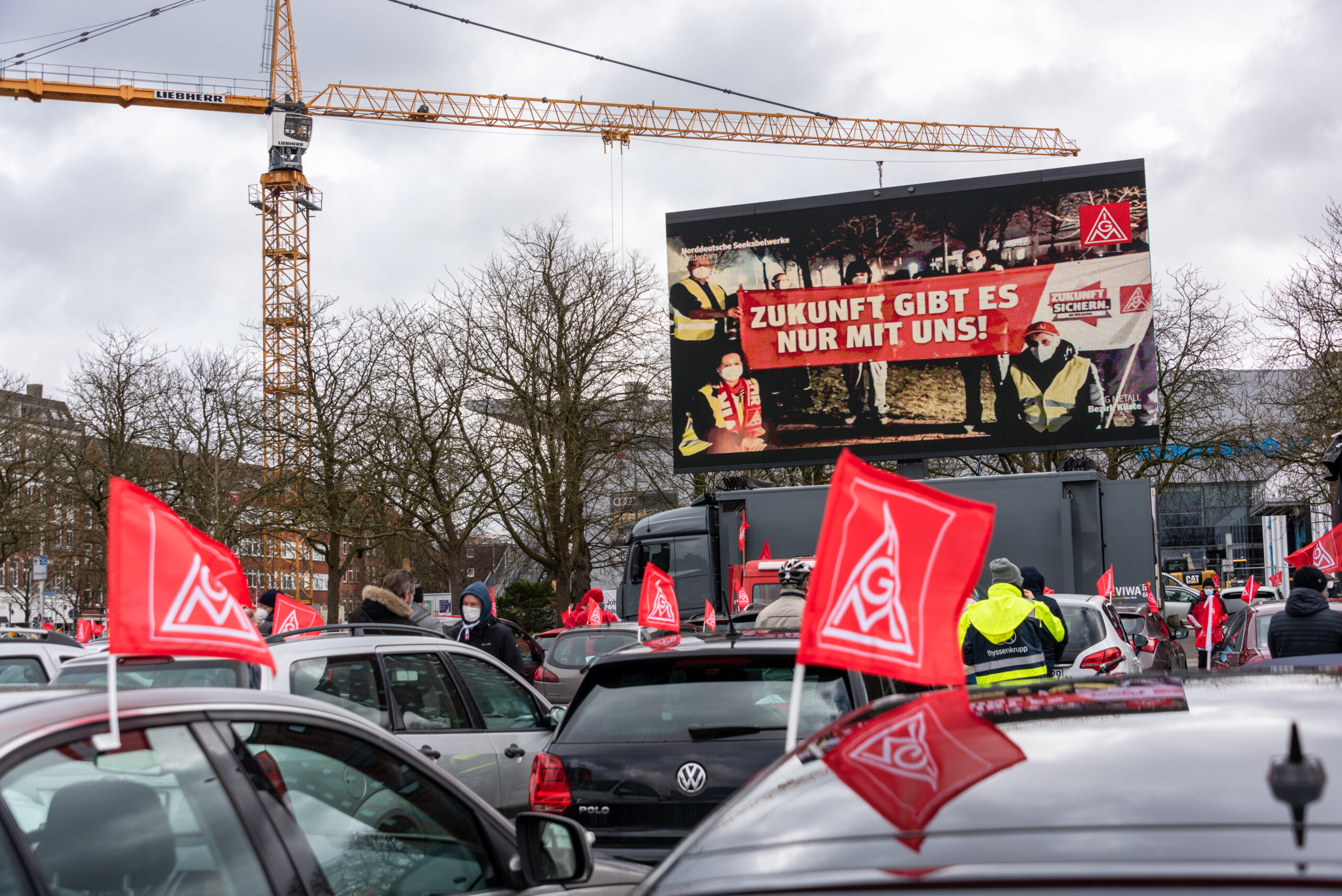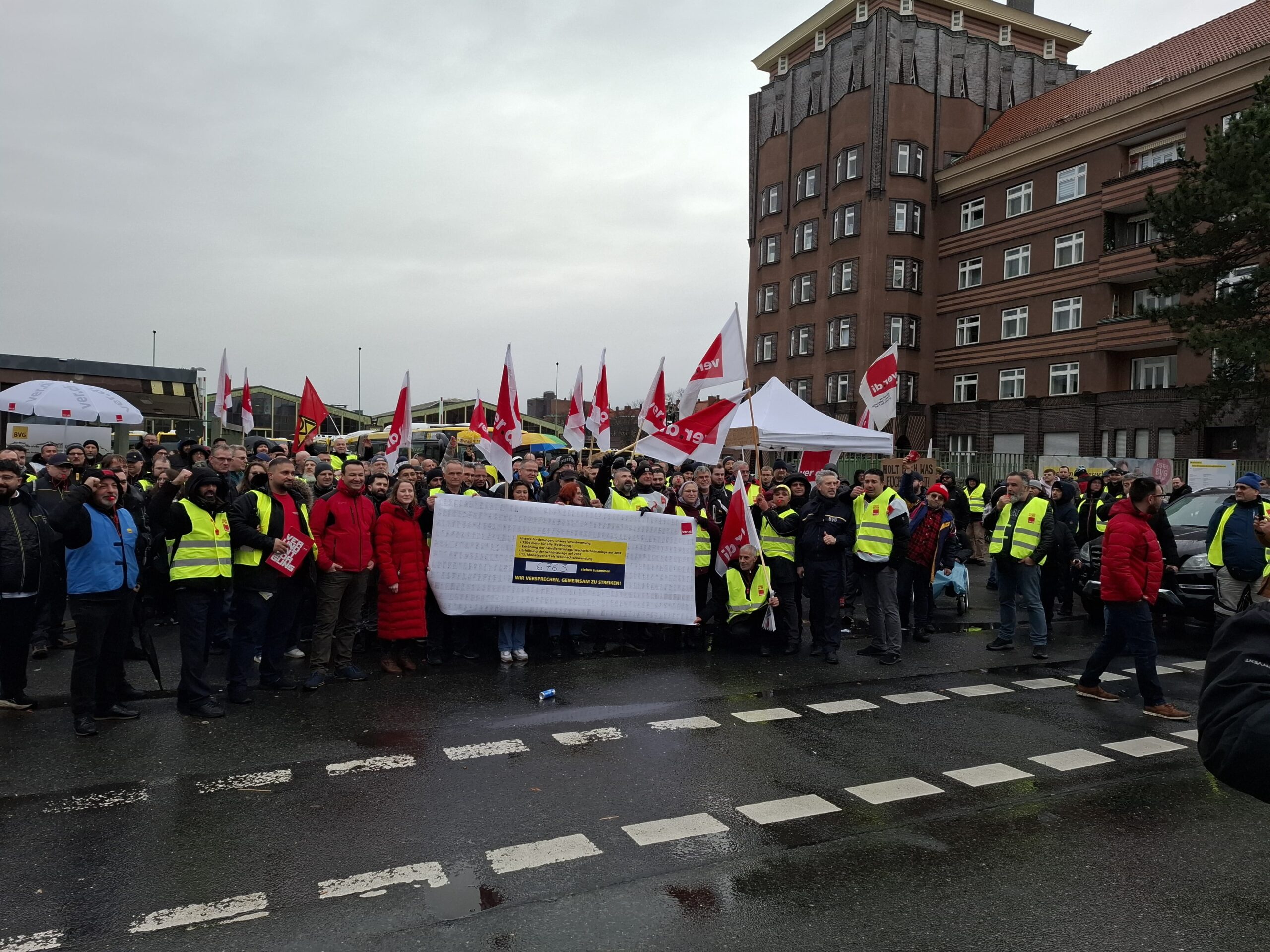Fight the platforms: Self-Organization against „Capitalism of the 21st Century”

Platforms like Amazon or Gorillas create new technical means. And on top a precarious proletariat that leads new struggles.
Since February, the workers of Gorillas have been fighting. The delivery service was founded just last year and it is already a shining star on the start-up scene with a market value of more than one billion euros. Gorillas is a so-called „platform company“, so a company that sees itself as an intermediary between service providers and customers and earns money through commissions from this arrangement.
This article is an introduction to our #5 issue of Klasse gegen Klasse magazine and traces the genesis of platform companies like Gorillas. The article will highlight that these companies build their fortunes on the basis of the extreme – and in capitalism already well-known – precarization of workers. Afterwards, a perspective is discussed on how workers can fight against these conditions.
Platforms themselves are a more recent phenomenon of capitalism, but have existed since the late 1990s. For example, eBay in Germany has provided a platform for second-hand goods since 1999 and increasingly for the commercial sale of new goods. Unlike in the 1990s, however, the provision of platforms today plays a central role in the global economy. Of the ten companies with the largest market capitalization in 2020, five rely significantly on platforms. And other companies, such as Tesla, still think about the idea of platformizing their goods.
This development goes so far that there are voices that assume that a new form of capitalism has developed with the platformization of the world of work: On the one hand, there are prophets of digital progress, who hope that digitization and the associated restructuring of the labor market will lead to a new, better and more crisis-proof version of capitalism – entrepreneurs and „techno-optimistic“ mainstream authors such as Andrew McAfee and Martin Ford. Even the FDP’s current election program is saturated with the assumption that enough innovation would be a meaningful way forward. On the other hand, there are some theorists of „post-capitalism“ like Aaron Bastani, who expect technological advances to lead to a virtually automatic transition to socialism.
At the same time, many leftists and labor lawyers, such as the German sociologist Wolfgang Streeck, see in the platforms and especially in the uncontrollability of the algorithms a development that massively complicates struggles against the capitalist system or even makes them impossible. Jeff Bezos, who is competing with Elon Musk for the title of the richest man in the world, built his unimaginable wealth on the backs of the workers of his platform company Amazon. Platform companies like Amazon are growing at a dizzying rate and even benefiting from the ongoing Corona crisis. Likewise, the number of „gig workers“ is growing. Exact numbers are hard to find, but already in 2018, about 15 percent of China’s workers worked for platforms. So not only has the power of the companies and their technology grown, but so has the army of workers they employed.
Where does the platform economy come from?
If we take a look at the material foundations for the platform economy, it becomes clear that this new form of structuring companies is not completly new. It is, above all, an adaptation of capitalism to the changing conditions of the global economy.
The emergence of platforms and their rise are consequences from the bursting of the dotcom bubble in 2000. The vast amounts of capital that had flowed into the sector, as well as future investments, had to find a new „job.“ Companies like Google formed from the rubble of the burst bubble.
But the dotcom boom also changed the means of production: the incredibly high investments laid the foundation for new digital products. Workers learned the expertise needed to develop platforms. Digital infrastructures, first and foremost the World Wide Web, were developed or adopted in general production in order to structure production on a broad scale.
From these material foundations, an extremely agile sector has emerged in which large amounts of venture capital, in particular, can be invested. A sector whose investors expect that most companies will go bust, but the survivors could be the next Amazon. A sector that is extracting data as a „raw material“ for the first time and making it capitalizable.
Since the groundwork was laid in the 1990s and 2000s, platforms have spread rapidly. One of the reasons for this is the astronomical growth of cell phone users recent years. By 2020, 3.5 billion people were smartphone users – that’s just under half the world’s population.
Amazon, Uber, Airbnb are some of the apps we now use as a natural part of our daily lives. For example, if you need a ride, Uber connects you with another user who will take you where you want to go in their own vehicle for a fee; the app keeps a portion of the price payed.
In terms of employment, these platforms are part of the so-called gig economy, which we can define as the opposite of traditional stable employment: In it, jobs are temporary, by objectives, intermittent and flexible, and the Internet always appears as an intermediary between the parties. As journalist Tamara Tenenbaum notes, there are two distinct gig markets: those that do highly skilled jobs and deliver 100 percent digital products; and those that are hired online but then handle the transaction offline, like cab drivers or cleaners.
The first group consists of so-called freelancers, mostly professional freelancers, who can easily negotiate the value of their products. The second consists of people who are usually young and less qualified, who receive low wages and suffer from precarious employment conditions; it is this latter group from which companies recruit their workers like gorillas.
Old capitalism, new appearance
A lot of energy goes into promoting platform companies. Everything is done to appear hip, flexible, modern, environmentally conscious and fair, like an alternative that is best for everyone, including the workers. But at its core, the platform economy is based on the familiar exploitation mechanisms of capitalism. Jeff Bezos himself put it in a nutshell when he commented on his space trip – with no scientific purpose at all, just for pure pleasure – „I also want to thank all Amazon employees and Amazon customers. Because you paid for all of this.“ And indeed the workers were creating the added value he needed for his unworldly and cynical space mission.
In a historical article accompanying this issue of the magazine, Marco Helmbrecht explains that in some ways it might even be more appropriate to think of platform economics as an older expression of capitalism, rather than a newer one. For it picks up the ways and means of an earlier phase of capitalism: a return and at the same time intensification of extremely precarious and fragmented structurings of labor – digital day labor.
In her book Los dueños de internet (Eng: The Owners of the Internet), political scientist Natalia Zuazo emphasizes that platform companies are in fact anything but „collaborative“. On the contrary, they are rather „traditional companies that use the Internet to mediate between and extract profits from many connected individuals.“ Calling what these companies do „social collaboration“ is, Zuazo denounces, „a technology-mediated euphemism for something we already knew: working hard so others can earn.“ This is already proven by observing the absolutely precarious conditions under which they keep their hundreds of thousands of employees. An exploitation of labor that is all too reminiscent of the capitalist enterprises of the 19th century because of its inhumane shifts, its brutal lack of protection, and its miserable wages. Ultimately, „platform capitalism“ is not a new form of capitalism, but the emergence of a new sector.
Fight the platform! But how?
Workers in the platform sector are among the most precarious workers in several aspects. Many of them – especially in delivery services – are migrants, many with insecure residence status. Companies like Gorillas take advantage of the racist labor and migration regime to increase their profits. Accordingly, opportunities to organize are often limited – from the unwillingness of reformist union apparatuses to organize these less profitable sectors to the fragmentation and isolation of workers, there are barriers that hinder platform workers. Sociologist Ana Cárdenas Tomažič and discusses these issues in a conversation for KGK Magazine.
Despite the adverse conditions, platform workers are organizing again and again – for better working conditions, for the right to establish works councils and union memberships, but also against racist and sexist discrimination and for overall social demands. Examples of this are numerous around the world. To mention just two of them: Amazon workers in Germany have been fighting for a collective agreement in nine distribution centers since 2013. To date, no collective agreement has been signed, but thousands of workers have mobilized in countless days of strikes to win improvements such as wage increases, break and sick leave regulations. Amazon workers in the U.S. are also fighting for the right to unionize – despite nasty management tricks and bureaucratic top-down union machinery.
There have also been organizing processes in the delivery platform sector for years. Readers in this country may remember the struggle of the Deliveroo drivers, who fought for a works council and unionization under the name „Deliverunion“ before the parent company withdrew from the German market. In Latin America, the Colombian „online delivery company“ Rappi has been around for years (see the review of this struggle in this magazine). Rappi’s business model is the precarization of its workers taken to the extreme: Not only do they have to use their personal cell phones and their own bicycles or motorcycles, but they also have to buy uniforms and backpacks from the company itself. Fixed employment contracts are practically non-existent; Rappi treats its workers as self-employed. Nevertheless, in July 2018, the workers:inside organized the first strike at Rappi in Argentina: They stopped – literally – „the motorcycle“ and raised their voice against the Colombian company. Through a Whatsapp group, the bot:ins organized a strike during peak working hours. Their method was to gather at certain points in Buenos Aires, activate the app, but not take orders. Rappi learned about the protest in advance and tried to lure strikebreakers with bonuses, but the protest action was successful and meant chaos for the company.
Another very recent example is the struggle of the workers of Gorillas in Berlin. Due to several wild days of strike and radical struggle measures such as warehouse blockades, Gorillas had to temporarily stop operations several times. The demands of the workers have not been met by far, but the Gorillas Workers Collective is fighting to organize an ever increasing number of riders with high-profile actions and a strike fund. In a commentary in this issue of the magazine, Anna Huber links this strike to a perspective of the socialization of production and reproduction work.
For it is precisely here that the central challenge of the precarious sectors lies: Where organizing is difficult, it is easy for a militant vanguard to emerge that organizes a part of the workers with radical forms of struggle and demands, but still remains in the absolute minority. This can lead to their struggle going nowhere. The reasons for this are manifold: high turnover among colleagues, extreme material hardship, being left in the lurch by union leaders who do not expect any organizing success, and the resignation resulting from these factors are dangers.
In contrast, isolation and fragmentation must be overcome in order to organize the majority of workers for struggle. They must organize together, no matter what union they belong to, what labor contract or legal status they have, and seek solidarity with sectors that are in strategic positions in the economy. In the case of the gorilla workers, for example, this could be the workers of the logistics companies that supply gorillas or the food factories from which the products come. But also a closing of ranks with other platform sectors like the platformized cleaners and caregivers is useful and necessary.Another very current example is the struggle of the workers of gorillas in Berlin. Due to several wild days of strikes and radical struggle measures such as warehouse blockades, Gorillas had to temporarily shut down operations several times. The demands of the workers have not been met by far, but the Gorillas Workers Collective is fighting to organize an ever increasing number of riders with high-profile actions and a strike fund. In a commentary in this issue of the magazine, Anna Huber links this strike to a perspective of the socialization of production and reproduction work.
Only if the precarious vanguard sets out to reach the largest possible section of workers and become a model for the closing of ranks of the most diverse sectors of workers can the spiral of ever more sophisticated surveillance and exploitation algorithms and ever more inhumane working conditions be stopped. For this, there must be an alliance of the most militant sectors with those sectors that can most effectively paralyze capitalist commodity production and circulation. In Germany, for example, this would be the workers of the automobile industry or logistics workers, as in the case of the railroads.
This is opposed not only by the objective barriers of the sector described above, but also by the bureaucracies of the large unions. The example of Amazon is particularly instructive here: In Germany, the service sector union ver.di is putting obstacles in the way of international grassroots organizing – despite the obvious need for coordinated struggle across national borders. In the U.S., the union bureaucracy of the RWDSU (Retail, Wholesale and Department Store Union) in Bessemer, Alabama, relied on the support of President Joe Biden instead of the active self-organization of the rank and file workers. The bureaucracy thus showed very clearly that the workers are for them nothing but a maneuvering mass for the negotiating table, over which they as „experts“ do not want to lose sovereignty.
Unite precarious workers – democratic, self-organized and anti-bureaucratic class-struggle
Our approach is incompatible with this: We believe that what is needed is a broad organization of workers at the base, who decide for themselves in assemblies and committees on their demands and measures of struggle and democratically take their fate into their own hands.
To achieve this, it is not enough to accuse the apparatus and the functionaries of the union, but the framework with which the union leaderships want to keep the struggle in narrow „economic“ channels must also be exposed in terms of content and politics. Gorillas shows here very clearly that the political demands that have been raised concern broad sections of the working class, especially the precariously employed: In order to overcome the inhumane practice of fixed-term contracts at the delivery service, a struggle must also be waged against the racist labor and migration regime that provides the legal basis for extreme precarization. And this is precisely what the trade union bureaucracy cannot and will not do. For it would mean radically questioning the social partnership basis of the trade union apparatus and practicing the broadest possible worker:inner democracy in struggle, which would take the decision about the struggle out of the hands of the apparatus. The trade union apparatus cannot allow this, not even the more left-wing trade union officials. Against this apparatus, it is therefore a task that cannot be postponed, especially of the precarious vanguard, to build an anti-bureaucratic current within the unions that cannot be replaced by party or micro-unions that leave the actual bureaucratic leaderships of the DGB unions untouched.
Gorillas can become a beacon in the struggle of precarious workers. If it is possible to organize the majority of Gorillas workers and link up with the workers of other platform companies, and if a program is established that provides answers to the burning questions of our time, their struggle can inspire hundreds of thousands of workers. Such flagship organizations are the starting point of what we call „Soviet strategy“: the struggle against he fragmentation of the working class, with the tools of a broad united front and the perspective of reclaiming the trade unions, building organs of self-organization up to councils („soviets“). Only in this way can we arrive at a revolutionary political organ of the working class that can conquer a workers:inside government and overcome capitalism with a socialist revolution.
There is still a long way to go, but struggles like Gorillas can lay the groundwork for networking precarious workers into committees that put forward a program for the whole class and a way out of the ongoing capitalist crisis.







